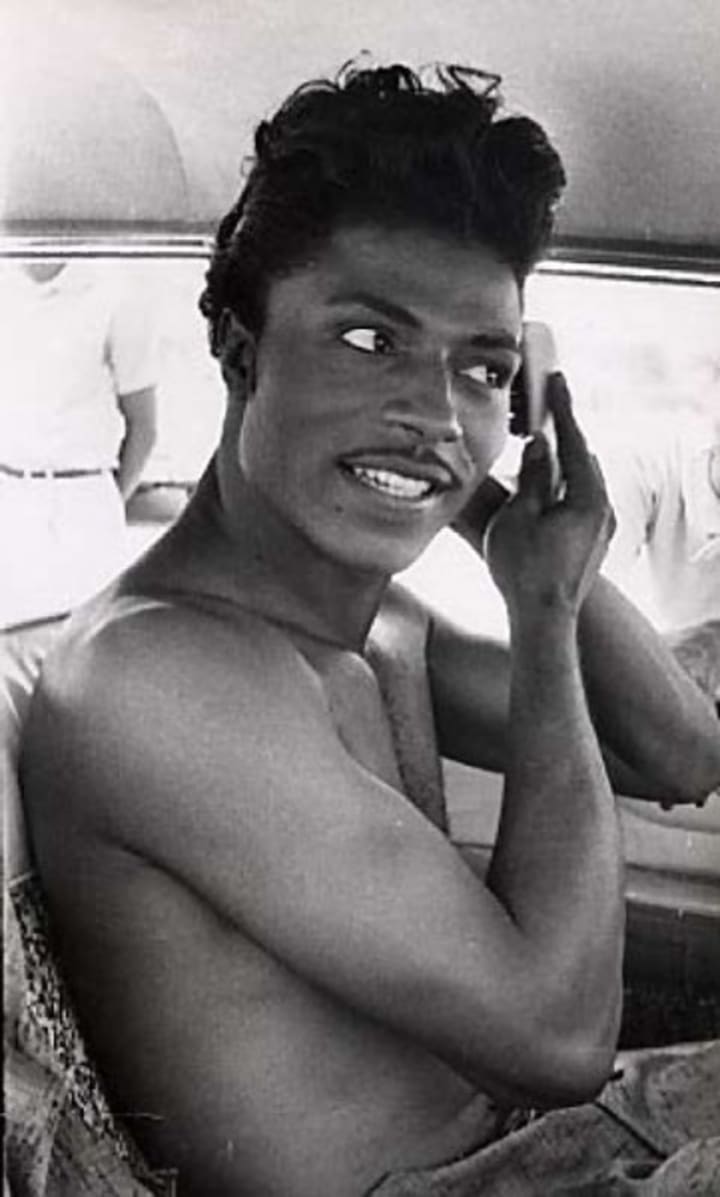
Background
Richard Penniman was born on December 5, 1932, in Macon, Georgia. The third of twelve siblings, Richard grew up in a very religious family. It was in church where the young Richard first discovered his love for music and performance, making good use of his loud singing voice in church. Soon after, he began to learn instruments such as the saxophone and later, the piano which he later became most associated with.
His more effeminate, softer appearance compared to the rest of his brothers coupled with a mischievous and boisterous nature did not sit well with his conservative father. So, at the age of 13, Richard was made to leave home. Initially confined to listening only to Gospel music at home, Richard soon discovered R&B and later, became one of the early pioneers of Rock n Roll.
Richard soon found his style, pairing his powerful singing voice and proficiency on the piano with a wild, high energy style of performance. His look was also unique for the time. Initially performing in drag sometimes, Richard soon adopted a more androgynous appearance which consisted of heavy makeup, a pencil moustache and rounded off by various flamboyant outfits and hairstyles. Love him or hate him, he successfully caught the attention of a wide demographic. His audiences were not restricted by age, gender or even race, something which was especially rare in that time. With hits like Tutti Frutti, Good Golly Miss Molly and Long Tall Sally, Richard had firmly established himself as one of the top artists of the 1950s. By the time the 60s came about, he was already recognised as a musical legend.
Becoming the Architect
Despite his reputation for brash and boastful claims, it could not be disputed that Richard was more than deserving of the moniker he wore with such pride. His style, look and musicianship paved the way for some of music’s most iconic names. At times, he directly gave a platform to aspiring musicians who eventually grew into legends of the industry. He gave opportunities for them to play in his band, open his shows and was generous in giving advice or serving as a mentor to the generations of musicians who came after him.
A brief testament to Richard’s influence can be seen in Rolling Stone Magazine’s list of the top 100 greatest artists. While Richard came in the eighth position, six of the seven artists that came above him (and several others who came below) either cited him as an inspiration or had come under his mentorship at some point early in their careers. The remaining artist, Chuck Berry, who came in fifth, was a friend and contemporary of Richard with a comparable legacy who himself was an admirer of Richard’s music. Both men often performed together and were instrumental in destigmatizing the genre of Rock n Roll itself and by using their music to appeal to both black and white audiences in a time where segregation was still prevalent.
Artists Influenced by Little Richard
The Beatles

Nothing says influential more than being the inspiration of the greatest band of all time. John Lennon and Paul McCartney (who themselves later went on to be recognised as one of, if not the greatest songwriting duos of all time), became friends due to their shared admiration of Richard’s music. In their earliest days as blossoming musicians, they often performed covers of his songs and borrowed his musical technique of songwriting when creating songs of their own.
However, Richard’s influence on The Beatles did not stop at just being an inspiration. In the early 1960s after their first stint in Hamburg and growing success in their hometown of Liverpool, the group had become more seasoned performers. In late 1962, they were given an offer to return to Hamburg to open for Richard and jumped at the chance. It was their biggest break to date and they were excited to be on the same show as the man they idolised. They made use of this time to learn and observe him and Richard in turn, was generous enough to share his advice and vocal exercises with the band.
Richard was impressed enough with the band that he followed them back to Liverpool after their dates in Hamburg to watch them perform in front of their hometown fans. It was after this performance that Richard foresaw big things lying in wait for the four boys from Liverpool. Just over a year later, he was proven right.
Bob Dylan

Often recognised as the greatest songwriter of all time (with a Nobel Prize to boot), Bob Dylan and Little Richard did not spend any considerable amount of time together until much later in both men’s careers. Despite this, Dylan idolised him from a very young age so much so that one of his earliest written songs on record was titled Hey Little Richard.
Another more famous tale of Dylan’s admiration of Richard was when he wrote in his high school yearbook that it was his life’s ambition to play in Little Richard’s band. This ambition was eventually realised when the two performed together for a few in Europe in the 90s. It was the fulfilment of a long held dream of an impressionable young man who at that point was already a bona fide legend in his own right. Although their styles were completely different from one another, Dylan never stopped admiring Richard and upon Richard’s death in 2020, Dylan described him as “my shining star and guiding light when I was only a little boy”
Jimi Hendrix

Now known as the greatest guitarist of all time, the icon that is Jimi Hendrix was once a struggling sideman looking for a steady gig to make ends meet. Having met Richard as a teenager while he was preaching at a church in Seattle, Hendrix was fascinated by the man and soon began his own musical journey. At this time Richard himself was beginning to return to Rock n Roll after a spell in Christian music. A series of events soon brought the two men back together just five years after their first encounter with Hendrix now under the employ of Richard as his guitarist. Although it was not his intention to play in Richard’s band at that point, he was nonetheless excited by the opportunity.
Unlike his relationships with other musicians at the time, the relationship between the two was professional at best and acrimonious at worst. Hendrix often tried to emulate his boss much to Richard’s chagrin. Soon enough, his playing in the group became far less subdued and more eyes were being drawn to him instead of Richard. By 1965, Hendrix was fired by Richard but he soon found great success of his own just around a year later. While accounts vary of what exactly transpired between the two men, what cannot be denied is that Richard gave Hendrix the platform that eventually launched him into the stratosphere and made him into the icon we now know him as today.
Prince


Like Richard himself, Prince made a name for himself through his combination of musical talent and flamboyant stage presence. One could even say that it was Prince who was able to take Richard’s style forward into more contemporary times and kept it firmly in the mainstream ever since. Like David Bowie (another artist who has credited Richard as an inspiration), Prince was able to borrow from the style set by Richard and make it into his own, taking a far more sensual and experimental approach while still commanding the highest musical integrity.
However, even from the offset of his career, parallels between the two were inevitably drawn. So much so, that Richard himself once addressed them. Declaring Prince as “the Little Richard of his generation” Richard was also quick to joke that he wore Prince’s signature purple colour, long before Prince himself ever did. Prince, while never acknowledging anything outright, subtly paid tribute to Richard on the cover of his Parade album, posing in a black and white photo donning Richard’s signature make-up, hairstyle and moustache. Those close to Prince have also commented on the noticeable resemblance with his costume designer Arianne Phillips saying that, “there would be no Prince without the King.”
Richard’s Legacy
Richard’s influence not only shaped the careers of the iconic musicians we know today, it revolutionised our very concept of music itself. Just like in more recent times Hip-Hop was brought from the underground to the mainstream, Richard and his contemporaries were hard at work trying to destigmatize Rock as being more than “sinful” or “vulgar”.
When a performance was often sober and subdued, Richard brought a festive and lively atmosphere which set the precedent for the concerts we see today. In addition to the performances, the flamboyance and theatrics we see today could not have been possible had it not been for Richard who paved the way. A whole generation of artists who are more comfortable in their own skin or more willing to push boundaries owe it to Little Richard for opening up that avenue for them.
Most of all, Little Richard, as did his contemporaries, used music as a tool to bring people together. There was no longer music for blacks or whites or music for rich and poor. There was just Rock n Roll and it was for anybody who wanted to listen. His music brought people together during one of the most divisive periods in recent history and since then, music has continued to stay as one of the best ways to unite people from all walks of life.
Over a year on from Richard Penniman’s passing at the age of 87, let us take the time to recognise the man who broke boundaries, set precedents and inspired generations of icons into shaping the way we enjoy music today. It’s not easy to blaze a trail without someone there to first pave the way and that someone is more than deserving of being called “The Architect.”
About the Creator
Isa Nan
Written accounts of life, death and everything in between






Comments
There are no comments for this story
Be the first to respond and start the conversation.